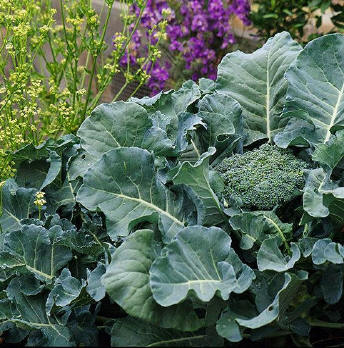 (7/7) It's mid July and I've already started my parsnips, broccoli, and Swiss chard. I'm getting ready to put in kale, rutabagas and carrots, too. Oh, I'm still looking forward to two months of luscious tomatoes, peppers, summer squashes, green beans, but it's time to think ahead to our
second cool season of the year - and more great produce.
(7/7) It's mid July and I've already started my parsnips, broccoli, and Swiss chard. I'm getting ready to put in kale, rutabagas and carrots, too. Oh, I'm still looking forward to two months of luscious tomatoes, peppers, summer squashes, green beans, but it's time to think ahead to our
second cool season of the year - and more great produce.
The fall and winter garden is similar to the spring garden - we grow vegetables that are mostly leaves, stems, and roots, not fruits. Summer is the time for growing tomatoes, beans and squash, which are fruits. Fruits need more energy from the environment in the form of sunlight and warm temperatures, and they take more time to mature. They grow
best when the temperatures are warmer and the days are longer.
The conditions faced by gardeners as winter approaches will favor lettuce, carrots, and similar vegetables. Shorter days result in less time for those plant cells to convert sunlight into their food energy. The cooler temperatures mean slower growth because the reactions which energize plants' cells are temperature-dependent. But, as an added
bonus, fall crops become sweeter with the cool temperatures as starches turn to sugars which act as an antifreeze to protect the plants' cells during cold months.
How is winter gardening different than summer gardening? There are a few differences, based on working with cool temperatures and short days.
Handling cooler temperatures: If you want to extend your late garden beyond the first frost, you need to protect it from the cold. There are a number of techniques - cloches, row covers and clear plastic sheeting all work. The more robust the covering, the colder the temperatures it can handle. Row covers are good to about 28oF. I've maintained
several garden rows all winter under 6 mil greenhouse plastic. Watch out with plastic, though. As the days get longer and warmer, it gets hot beneath plastic; overheating and some diseases can become a problem. You need to be able to open your plastic tunnels to allow good air circulation when it gets warm.
Weeds: Many weeds I encounter are called winter annuals. They're the ones that start growing in the fall and really take off when the weather gets warm in the spring. They usually grow faster than my vegetables. I find myself weeding during those few warm days that occur mid to late winter, but I usually allow a few weeds to flower for early
pollinators.
Pests: In the fall, it's possible to trap some insects under your protective covering. Once there, they will happily eat all the food you provide. Be vigilant or you will be sharing your kale with caterpillars. One year I was shocked to find wilted carrot tops where robust greens stood two days before. A vole decided my plastic-covered tunnel was a
warm, well stocked larder, protected from predators.
Planning: When do you want the vegetables to mature? Will they finish at the first frost or will you keep some vegetables going all winter? Once you know what you are planting and when you want it to mature, find out how many days it takes -- found on the seed packet or the seed catalog. Add 7-10 days for cooler temperatures, and count back on the
calendar.
Root vegetables are best matured by November, and you don't have to worry about fancy covers. Carrots, parsnips, beets, turnips and rutabagas can be protected by a thick mulch to keep the soil from freezing. Then they can be harvested as you want them. I plant spinach twice -- once early in August for fall harvest and a savoy type in late September
to mature the following spring. They survive unprotected as a rosette of leaves that hibernate until the temperatures warm. I start Swiss chard, broccoli, kale and brussel sprouts indoors about now and put them out late in August. Brussel sprouts will mature over the winter; broccoli and fall kale are pretty much done by Christmas. I missed the planting date with broccoli
last year, so I protected it, and instead of having it for Christmas, it matured for Valentine's Day.
If there is a down side to cool season gardening, it would have to be that an iced tea on the back porch after a couple hours of gardening in February isn't nearly as appealing as it is in July.
Read other articles on plants and gardens